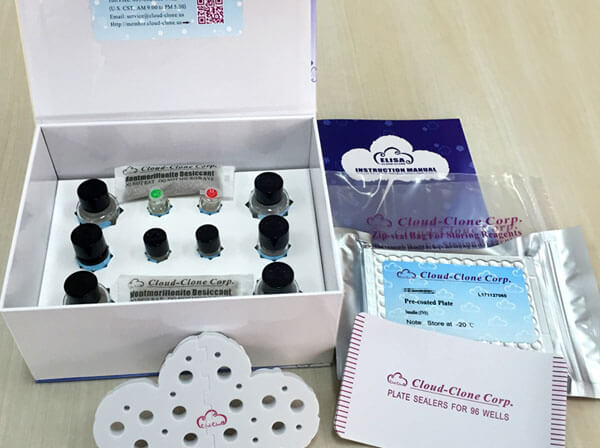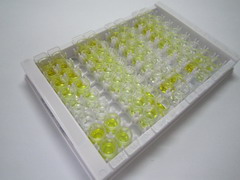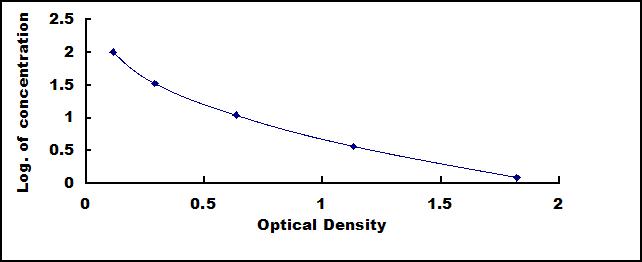ELISA Kit for Quinolinic Acid (QA) 

QUIN; Pyridine-2,3-Dicarboxylic Acid
- UOM
- FOB US$ 571.00 US$ 816.00 US$ 3,672.00 US$ 6,936.00 US$ 57,120.00
- Quantity
Overview
Properties
- Product No.CEK552Ge
- Organism SpeciesPan-species (General) Same name, Different species.
- ApplicationsEnzyme-linked immunosorbent assay for Antigen Detection.
Research use only - DownloadInstruction Manual
- Category
Sign into your account
Share a new citation as an author
Upload your experimental result
Review

Contact us
Please fill in the blank.
Recovery
Matrices listed below were spiked with certain level of Quinolinic Acid (QA) and the recovery rates were calculated by comparing the measured value to the expected amount of Quinolinic Acid (QA) in samples.
| Matrix | Recovery range (%) | Average(%) |
| serum(n=5) | 90-98 | 94 |
| EDTA plasma(n=5) | 81-99 | 93 |
| heparin plasma(n=5) | 90-98 | 93 |
Precision
Intra-assay Precision (Precision within an assay): 3 samples with low, middle and high level Quinolinic Acid (QA) were tested 20 times on one plate, respectively.
Inter-assay Precision (Precision between assays): 3 samples with low, middle and high level Quinolinic Acid (QA) were tested on 3 different plates, 8 replicates in each plate.
CV(%) = SD/meanX100
Intra-Assay: CV<10%
Inter-Assay: CV<12%
Linearity
The linearity of the kit was assayed by testing samples spiked with appropriate concentration of Quinolinic Acid (QA) and their serial dilutions. The results were demonstrated by the percentage of calculated concentration to the expected.
| Sample | 1:2 | 1:4 | 1:8 | 1:16 |
| serum(n=5) | 82-101% | 80-99% | 96-105% | 89-96% |
| EDTA plasma(n=5) | 93-101% | 84-96% | 99-105% | 83-104% |
| heparin plasma(n=5) | 81-99% | 91-102% | 94-105% | 98-105% |
Stability
The stability of kit is determined by the loss rate of activity. The loss rate of this kit is less than 5% within the expiration date under appropriate storage condition.
To minimize extra influence on the performance, operation procedures and lab conditions, especially room temperature, air humidity, incubator temperature should be strictly controlled. It is also strongly suggested that the whole assay is performed by the same operator from the beginning to the end.
Reagents and materials provided
| Reagents | Quantity | Reagents | Quantity |
| Pre-coated, ready to use 96-well strip plate | 1 | Plate sealer for 96 wells | 4 |
| Standard | 2 | Standard Diluent | 1×20mL |
| Detection Reagent A | 1×120µL | Assay Diluent A | 1×12mL |
| Detection Reagent B | 1×120µL | Assay Diluent B | 1×12mL |
| TMB Substrate | 1×9mL | Stop Solution | 1×6mL |
| Wash Buffer (30 × concentrate) | 1×20mL | Instruction manual | 1 |
Assay procedure summary
1. Prepare all reagents, samples and standards;
2. Add 50µL standard or sample to each well.
And then add 50µL prepared Detection Reagent A immediately.
Shake and mix. Incubate 1 hour at 37°C;
3. Aspirate and wash 3 times;
4. Add 100µL prepared Detection Reagent B. Incubate 30 minutes at 37°C;
5. Aspirate and wash 5 times;
6. Add 90µL Substrate Solution. Incubate 10-20 minutes at 37°C;
7. Add 50µL Stop Solution. Read at 450 nm immediately.

Test principle
This assay employs the competitive inhibition enzyme immunoassay technique. An antibody specific to QA has been pre-coated onto a microplate. A competitive inhibition reaction is launched between biotin labeled QA and unlabeled QA (Standards or samples) with the pre-coated antibody specific to QA. After incubation the unbound conjugate is washed off. Next, avidin conjugated to Horseradish Peroxidase (HRP) is added to each microplate well and incubated. The amount of bound HRP conjugate is reverse proportional to the concentration of QA in the sample. After addition of the substrate solution, the intensity of color developed is reverse proportional to the concentration of QA in the sample.
Giveaways
Increment services
Citations
- M30 Antagonizes Indoleamine 2,3-Dioxygenase Activation and Neurodegeneration Induced by Corticosterone in the Hippocampus.pubmed:27870896
- Monoamine oxidase A upregulated by chronic intermittent hypoxia activates indoleamine 2, 3-dioxygenase and neurodegenerationpubmed:28599322
- Chronic Mild Stress Alters Kynurenine Pathways Changing the Glutamate Neurotransmission in Frontal Cortex of RatsPubmed:29725904
- Exercise training impacts skeletal muscle gene expression related to the kynurenine pathwayPubmed: 30649918
- Modification of kynurenine pathway via inhibition of kynurenine hydroxylase attenuates surgical brain injury complications in a male rat modelPubmed: 31257634
- Serotonin is the main tryptophan metabolite associated with psychiatric comorbidity in abstinent cocaine-addicted patientsPubmed: 31727978
- Kynurenine 3-monooxygenase upregulates pluripotent genes through β-catenin and promotes triple-negative breast cancer progressionPubmed: 32268268











